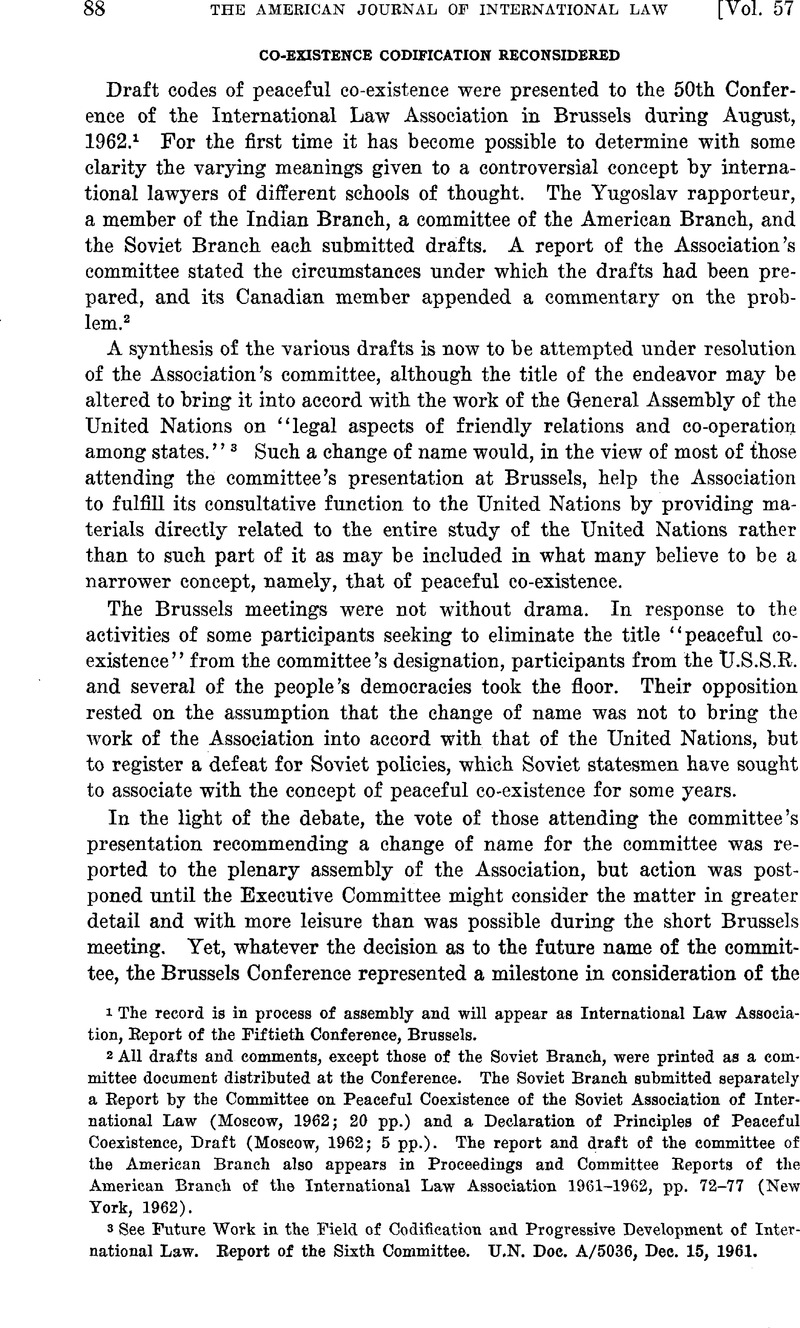Published online by Cambridge University Press: 28 March 2017

1 The record is in process of assembly and will appear as International Law Association,Eeport of the Fiftieth Conference, Brussels.
2 All drafts and comments, except those of the Soviet Branch, were printed as a committee document distributed at the Conference. The Soviet Branch submitted separatelya Eeport by the Committee on Peaceful Coexistence of the Soviet Association of InternationalLaw (Moscow, 1962; 20 pp.) and a Declaration of Principles of PeacefulCoexistence, Draft (Moscow, 1962; 5 pp.). The report and draft of the committee ofthe American Branch also appears in Proceedings and Committee Eeports of theAmerican Branch of the International Law Association 1961-1962, pp. 72-77 (NewYork, 1962).
3 See Future Work in the Field of Codification and Progressive Development of International Law. Eeport of the Sixth Committee. TJ.N. Doc. A/5036, Dec. 15, 1961.
4 This position might have been anticipated in the light of the debate within the Sixth Committee of the 16th General Assembly. Mr. Dorogin (Byelorussia) then said: “There was, of course, no question of making it [peaceful co-existence] the subject of a specialconvention, but it was a fundamental principle which should influence all the activitiesof the United Nations, including those of the International Law Commission.” See General Assembly, 16th Sess., Official Records, 6th Committee, Legal Questions, SummaryEecords of Meetings, Sept. 20-Dec. 15, 1961 (New York, United Nations, 1962),p. 175 (S.E. 724, par. 5). Mr. Capotorti (Italy) said likewise: “Peaceful coexistenceas it was usually understood was a political phenomenon which did not lend itself tocodification.” Ibid., p. 160 (S.E. 722, par. 6).
5 See Crane , Robert D., “Soviet Attitude Toward International Space Law,” 56 A.J.I.L. 684 at 710-723 (1962).Google Scholar
6 See McWhinney, Edward, “ ‘Peaceful Co-existence’ and Soviet-Western International Law,” 56 A.J.I.L. 951-970 (1962).Google Scholar
7 Prof. G. I. Tunkin, who also spoke for the Soviet Branch at the International Law Association Conference, said in the Sixth Committee:
“ . . . the trends in the old international law sanctioned the policy of force and theinstitutions of colonialism . . . but the old international law also contained democraticprinciples and progressive rules which remained in force. . . . The old international lawhad changed to such a point that today it was necessary to speak of a new internationallaw. That, however, did not mean that nothing had remained of the old internationallaw. Some of its parts remained in force with the necessary alterations but the differencesbetween the old and the new law ought to be pointed out. . . . ” Sixth Committee,Summary Eeeords of Meetings, cited note 4 above, at 211 (S.E. 729, par. 6).I t may be significant that Prof. Tunkin corrected a misrepresentation of his remarksin the provisional summary record which had made one sentence read: “The old internationallaw should not be rejected as a whole, since it was the foundation of modernlaw.” See U.N. Doc. Provisional A/C.6/SE.729, p. 3.
8 See report of Mr. Ulloa(Peru):“The difference between the international law of the past and that of the future was one of substance rather than form. Where in some spheres of international life international relations remained the same, the law of thepast could be maintained and perfected, but new types of relations should be governedby new rules.” Sixth Committee, Summary Eeeords of Meetings, cited note 4 above,at 193 (S.E. 726, par. 29). Mr. Yasseen (Iraq) said: “ . . . there was no doubt thatsince the establishment of the International Law Commission the situation in theinternational community had changed considerably from both the scientific and politicalpoint of view; . . . the slow evolution of customary law was no longer enough.” Ibid.,p. 175 (S.E. 724, par. 7).Mr. Eoseen (Israel) Baid: “ His delegation had been impressedwith the sincerity of those who held that traditional international law was nolonger satisfactory, although he thought that too broad a generalization to that effectmight be misleading.” Hid., p. 75 (S.E. 704, par. 3).
9 See report of Mr. Perera ibid. p. 210 (S.E. 728, par. 26).
10 See report of Mr. Pechota (Czechoslovakia),ibid., p. 170 (S.E. 723, par. 22).
11 See report of Mr. Jusuf (Indonesia) ibid., p. 71 (S.E. 702, par. 25).
12 See report of Mr. Jusuf(Indonesia) quoting speech of President Sukarno to the General Assembly on Sept. 30, 1960, ibid., p. 189 (S.E. 726, par. 6),
13 Resolution on the Legal Aspects of Coexistence. International Law Association,Keport of the Forty-Ninth Conference, Hamburg, pp. xxii-xxiii (London, 1961).
14 See report of Mr.Amado, (Brazil), Sixth Committee, Summary Records of Meetings,cited note 4 above, at p. 156 Google Scholar(S.E. 721, pars. 6 and 14), and report of Mr. Yasseen(Iraq), referring to remarks of Mr. Amado excised from the final report: “As the Brazilian representative had said . . . international law was the work not of professors but of States.” Ibid., p. 176 (S.E. 724, par. 10).
15 See report of Mr. Ustor (Hungary), ibid., p. 142 (S.E. 718, par. 16); of Mr. Amado (Brazil),ibid., pp. 155-156 (S.E. 721, pars. 6 and 21); and of Mr. Perera(Ceylon):“He referred, in particular, to the three conferences held by the InternationalLaw Association, which boasted a large membership from Western States . . . ”ibid., p. 210 (S.E. 728, par. 25).
16 The Executive Council of the International Law Association decided on Oct. 27,1962, after completion of this editorial comment, to continue the Committee on the Juridical Aspects of Peaceful Co-existence under its present name until 1964 to complete a list of the principles or rules of peaceful co-existence, and also to establish a new committee to examine and report on two topics: (1) the legal aspects of the emergence of new states into independence, and (2) the content of the legal rule of non-intervention in the internal affairs of other states.